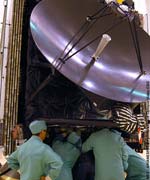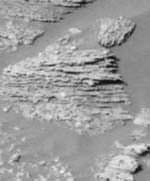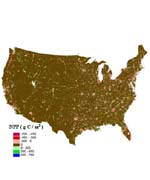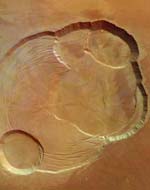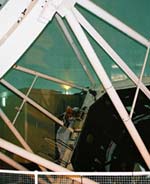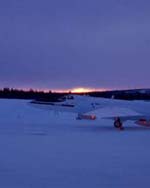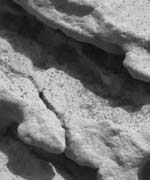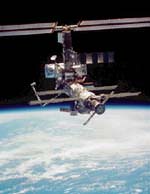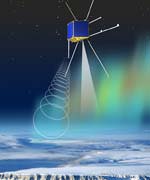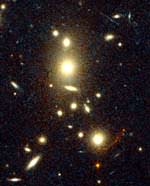
Image credit: Hubble
Many examples are known where a galaxy acts as a gravitational lens, producing multiple images on the sky of a more distant object like a bright quasar hidden behind it. But there has been a persistent mystery for over 20 years: Einstein’s general theory of relativity predicts there should be an odd number of images, yet almost all observed lenses have only 2 or 4 known images. Now, astronomer Joshua Winn of the Harvard-Smithsonian Center for Astrophysics (CfA) and two former CfA colleagues, David Rusin (now at the University of Pennsylvania) and Christopher Kochanek (The Ohio State University), have identified a third, central image of a lensed quasar. Radio observations of the system known as PMN J1632-0033 in the constellation Ophiuchus uncovered a faint central image, which can be used to investigate the properties of the lensing galaxy and the supermassive black hole expected to lie at its center.
“Finding this central image is interesting in its own right, but is even more important for what it can tell us about the lensing galaxy. This offers us a new tool for studying galaxies so far away that, even to the Hubble Space Telescope, they’re just faint smudges,” said Winn.
Quasars are extremely distant and bright objects believed to be powered by supermassive black holes. They shine brightly by converting the gravitational energy of matter falling into the black hole into light and other types of radiation, such as radio waves.
In gravitational lensing, light rays from a quasar which pass close to a galaxy are bent by the galaxy’s gravitational field, much as they would be bent when passing through a glass lens. The denser the center of a galaxy, and the stronger its gravity, the fainter the central image will be. Yet this central image, whose light has passed closest to the middle of the lensing galaxy, can tell us much about that galaxy’s core. That opportunity makes finding such central images particularly desirable.
In the system PMN J1632-0033, a radio-loud quasar at redshift z=3.42 (a distance of about 11.5 billion light-years) is being lensed by an elliptical galaxy at redshift z~1 (about 8 billion light-years away). Two images of the quasar were known to exist, and a third, very faint radio source was suspected to be the central image. However, that third source was right on top of the lensing galaxy, and so might have been intrinsic to the lensing galaxy itself.
By observing the radio “color,” or spectrum, of all three images using the National Science Foundation’s Very Large Array and Very Long Baseline Array, Winn and his colleagues provided compelling evidence that the third source is indeed the quasar’s central image. Its spectrum is essentially identical to the other two images, except at low frequencies where some of the radio energy was absorbed by the lensing galaxy.
The geometry and properties of the quasar’s three images already are telling us about the core of the lensing galaxy. For example, its central black hole weighs less than 200 million solar masses. Also, its surface density (amount of matter as projected against the plane of the sky) at the location of the central image is more than 20,000 solar masses per square parsec. (For comparison, the surface density of the Milky Way near our sun is about 50 solar masses per square parsec.) Both figures for the lensing galaxy agree with expectations based on detailed observations of galaxies hundreds of times closer to the Earth.
“Almost all of our knowledge about galaxy centers comes from studying very nearby galaxies. The remarkable thing about central images is that you can get similar information about the cores of galaxies hundreds of times farther away, and billions of years younger than our neighboring galaxies,” said Winn.
This research is available online at http://arxiv.org/abs/astro-ph/0312136 and will be published in the February 12, 2004 issue of the journal Nature.
Headquartered in Cambridge, Mass., the Harvard-Smithsonian Center for Astrophysics is a joint collaboration between the Smithsonian Astrophysical Observatory and the Harvard College Observatory. CfA scientists, organized into six research divisions, study the origin, evolution and ultimate fate of the universe.
Original Source: Harvard CfA News Release

